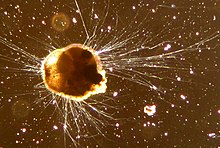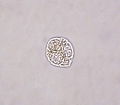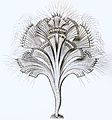| Revision as of 22:19, 4 September 2020 editCitation bot (talk | contribs)Bots5,426,245 edits Add: s2cid, author pars. 1-1. Removed URL that duplicated unique identifier. Removed parameters. Some additions/deletions were actually parameter name changes. | You can use this bot yourself. Report bugs here. | Suggested by AManWithNoPlan | All pages linked from cached copy of User:AManWithNoPlan/sandbox2 | via #UCB_webform_linked← Previous edit |
Revision as of 18:36, 26 November 2020 edit undoMonkbot (talk | contribs)Bots3,695,952 editsm Task 18 (cosmetic): eval 14 templates: del empty params (3×); hyphenate params (2×);Tag: AWBNext edit → |
| Line 15: |
Line 15: |
|
}} |
|
}} |
|
|
|
|
|
The '''Rhizaria''' are a species-rich supergroup of mostly ]<ref>{{cite web | url = http://www.palaeos.com/Eukarya/Units/Rhizaria/Rhizaria.html | year = 2004 | author = Christopher Taylor | title = Rhizaria | url-status = dead | archiveurl = https://web.archive.org/web/20090420034036/http://www.palaeos.com/Eukarya/Units/Rhizaria/Rhizaria.html | archivedate = 2009-04-20 }}</ref> ]s.<ref name="pmid15148395">{{cite journal |vauthors=Nikolaev SI, Berney C, Fahrni JF, etal |title=The twilight of Heliozoa and rise of Rhizaria, an emerging supergroup of amoeboid eukaryotes |journal=Proc. Natl. Acad. Sci. U.S.A. |volume=101 |issue=21 |pages=8066–71 |date=May 2004 |pmid=15148395 |pmc=419558 |doi=10.1073/pnas.0308602101 }}</ref> Except from the ] and three species in the genus ] in the phylum ], they are all non-photosynthethic, but many foraminifera and radiolaria have a symbiotic relationship with unicellular algae.<ref>{{Cite journal|last1=Gast|first1=Rebecca J.|last2=Caron|first2=David A.|date=2001-10-01|title=Photosymbiotic associations in planktonic foraminifera and radiolaria|journal=Hydrobiologia|language=en|volume=461|issue=1|pages=1–7|doi=10.1023/A:1012710909023|s2cid=1387879|issn=1573-5117}}</ref> A multicellular form, ''Guttulinopsis vulgaris'', a cellular ], has also been described.<ref>{{cite journal | url=http://www.cell.com/current-biology/abstract/S0960-9822(12)00413-7 | year = 2012 | author = Brown| title = Aggregative Multicellularity Evolved Independently in the Eukaryotic Supergroup Rhizaria |display-authors=etal | doi=10.1016/j.cub.2012.04.021 | volume=22 | issue = 12 | journal=Current Biology | pages=1123–1127 | pmid=22608512| doi-access=free }}</ref> |
|
The '''Rhizaria''' are a species-rich supergroup of mostly ]<ref>{{cite web | url = http://www.palaeos.com/Eukarya/Units/Rhizaria/Rhizaria.html | year = 2004 | author = Christopher Taylor | title = Rhizaria | url-status = dead | archive-url = https://web.archive.org/web/20090420034036/http://www.palaeos.com/Eukarya/Units/Rhizaria/Rhizaria.html | archive-date = 2009-04-20 }}</ref> ]s.<ref name="pmid15148395">{{cite journal |vauthors=Nikolaev SI, Berney C, Fahrni JF, etal |title=The twilight of Heliozoa and rise of Rhizaria, an emerging supergroup of amoeboid eukaryotes |journal=Proc. Natl. Acad. Sci. U.S.A. |volume=101 |issue=21 |pages=8066–71 |date=May 2004 |pmid=15148395 |pmc=419558 |doi=10.1073/pnas.0308602101 }}</ref> Except from the ] and three species in the genus ] in the phylum ], they are all non-photosynthethic, but many foraminifera and radiolaria have a symbiotic relationship with unicellular algae.<ref>{{Cite journal|last1=Gast|first1=Rebecca J.|last2=Caron|first2=David A.|date=2001-10-01|title=Photosymbiotic associations in planktonic foraminifera and radiolaria|journal=Hydrobiologia|language=en|volume=461|issue=1|pages=1–7|doi=10.1023/A:1012710909023|s2cid=1387879|issn=1573-5117}}</ref> A multicellular form, ''Guttulinopsis vulgaris'', a cellular ], has also been described.<ref>{{cite journal | url=http://www.cell.com/current-biology/abstract/S0960-9822(12)00413-7 | year = 2012 | author = Brown| title = Aggregative Multicellularity Evolved Independently in the Eukaryotic Supergroup Rhizaria |display-authors=etal | doi=10.1016/j.cub.2012.04.021 | volume=22 | issue = 12 | journal=Current Biology | pages=1123–1127 | pmid=22608512| doi-access=free }}</ref> |
|
This supergroup was proposed by ] in 2002. Being described mainly from ] sequences, they vary considerably in form, having no clear morphological distinctive characters (]), but for the most part they are ]s with filose, reticulose, or microtubule-supported ]s. Many produce shells or skeletons, which may be quite complex in structure, and these make up the vast majority of protozoan fossils. Nearly all have ] with tubular ]e. |
|
This supergroup was proposed by ] in 2002. Being described mainly from ] sequences, they vary considerably in form, having no clear morphological distinctive characters (]), but for the most part they are ]s with filose, reticulose, or microtubule-supported ]s. Many produce shells or skeletons, which may be quite complex in structure, and these make up the vast majority of protozoan fossils. Nearly all have ] with tubular ]e. |
|
|
|
|
| Line 50: |
Line 50: |
|
|
|
|
|
===Phylogeny=== |
|
===Phylogeny=== |
|
Phylogeny based on Bass ''et al.'' 2009,<ref name="pmid18952499">{{cite journal |vauthors=Bass D, Chao EE, Nikolaev S |title=Phylogeny of Novel Naked Filose and Reticulose Cercozoa: Granofilosea cl. n. and Proteomyxidea Revised |journal=Protist |volume=160 |issue=1 |pages=75–109 |date=February 2009 |pmid=18952499 |doi=10.1016/j.protis.2008.07.002 |display-authors=etal}}</ref> Howe ''et al.'' 2011,<ref name=Howe>{{citation | date=2011| author = Howe | title = Novel Cultured Protists Identify Deep-branching Environmental DNA Clades of Cercozoa: New Genera Tremula, Micrometopion, Minimassisteria, Nudifila, Peregrinia| volume=162 |issue= 2|pages=332–372 |journal=Protist | doi=10.1016/j.protis.2010.10.002 |display-authors=etal | pmid=21295519}}</ref> and Silar 2016.<ref name=Silar>{{citation | date=2016| author = Silar, Philippe| title = Protistes Eucaryotes: Origine, Evolution et Biologie des Microbes Eucaryotes| url=https://hal.archives-ouvertes.fr/hal-01263138| volume= |issue= |pages=1–462 |journal=HAL Archives-ouvertes | doi=}}</ref> |
|
Phylogeny based on Bass ''et al.'' 2009,<ref name="pmid18952499">{{cite journal |vauthors=Bass D, Chao EE, Nikolaev S |title=Phylogeny of Novel Naked Filose and Reticulose Cercozoa: Granofilosea cl. n. and Proteomyxidea Revised |journal=Protist |volume=160 |issue=1 |pages=75–109 |date=February 2009 |pmid=18952499 |doi=10.1016/j.protis.2008.07.002 |display-authors=etal}}</ref> Howe ''et al.'' 2011,<ref name=Howe>{{citation | date=2011| author = Howe | title = Novel Cultured Protists Identify Deep-branching Environmental DNA Clades of Cercozoa: New Genera Tremula, Micrometopion, Minimassisteria, Nudifila, Peregrinia| volume=162 |issue= 2|pages=332–372 |journal=Protist | doi=10.1016/j.protis.2010.10.002 |display-authors=etal | pmid=21295519}}</ref> and Silar 2016.<ref name=Silar>{{citation | date=2016| author = Silar, Philippe| title = Protistes Eucaryotes: Origine, Evolution et Biologie des Microbes Eucaryotes| url=https://hal.archives-ouvertes.fr/hal-01263138|pages=1–462 |journal=HAL Archives-ouvertes }}</ref> |
|
{{barlabel |size=18 |at1=7.5 |label1=Cercozoa|cladogram= |
|
{{barlabel |size=18 |at1=7.5 |label1=Cercozoa|cladogram= |
|
{{Clade| style=font-size:100%;line-height:80% |
|
{{Clade| style=font-size:100%;line-height:80% |
A few other groups may be included in the Cercozoa, but some trees appear closer to the Foraminifera. These are the Phytomyxea and Ascetosporea, parasites of plants and animals, respectively, and the peculiar amoeba Gromia. The different groups of Rhizaria are considered close relatives based mainly on genetic similarities, and have been regarded as an extension of the Cercozoa. The name Rhizaria for the expanded group was introduced by Cavalier-Smith in 2002, who also included the centrohelids and Apusozoa.
In 2019, the Cercozoa were recognized as a basal Rhizaria group, as sister of the Retaria.

 Cercomonas sp. (Cercozoa: Cercomonadida
Cercomonas sp. (Cercozoa: Cercomonadida
 Ebria sp. (Cercozoa: Ebridea)
Ebria sp. (Cercozoa: Ebridea)
 Rhipidodendron sp. (Cercozoa: Spongomonadea)
Rhipidodendron sp. (Cercozoa: Spongomonadea)
 Euglypha sp. (Cercozoa: Euglyphida)
Euglypha sp. (Cercozoa: Euglyphida)
 Phaeodarians (Cercozoa: Phaeodarea)
Phaeodarians (Cercozoa: Phaeodarea)
 Clathrulina elegans (Cercozoa: Granofilosea: Desmothoracida)
Clathrulina elegans (Cercozoa: Granofilosea: Desmothoracida)
 Chlorarachnion sp. (Cercozoa: (Chlorarachniophyta)
Chlorarachnion sp. (Cercozoa: (Chlorarachniophyta)
 Vampyrella sp. (Cercozoa: Vampyrellidae)
Vampyrella sp. (Cercozoa: Vampyrellidae)
 Gromia (Cercozoa: Gromiidea)
Gromia (Cercozoa: Gromiidea)
 Powdery scab (Cercozoa: Plasmodiophorida)
Powdery scab (Cercozoa: Plasmodiophorida)
 Foraminiferans (Retaria: Foraminifera)
Foraminiferans (Retaria: Foraminifera)
 Polycystines (Retaria: Radiolaria)
Polycystines (Retaria: Radiolaria)
 Acantharians (Retaria: Radiolaria)
Acantharians (Retaria: Radiolaria)